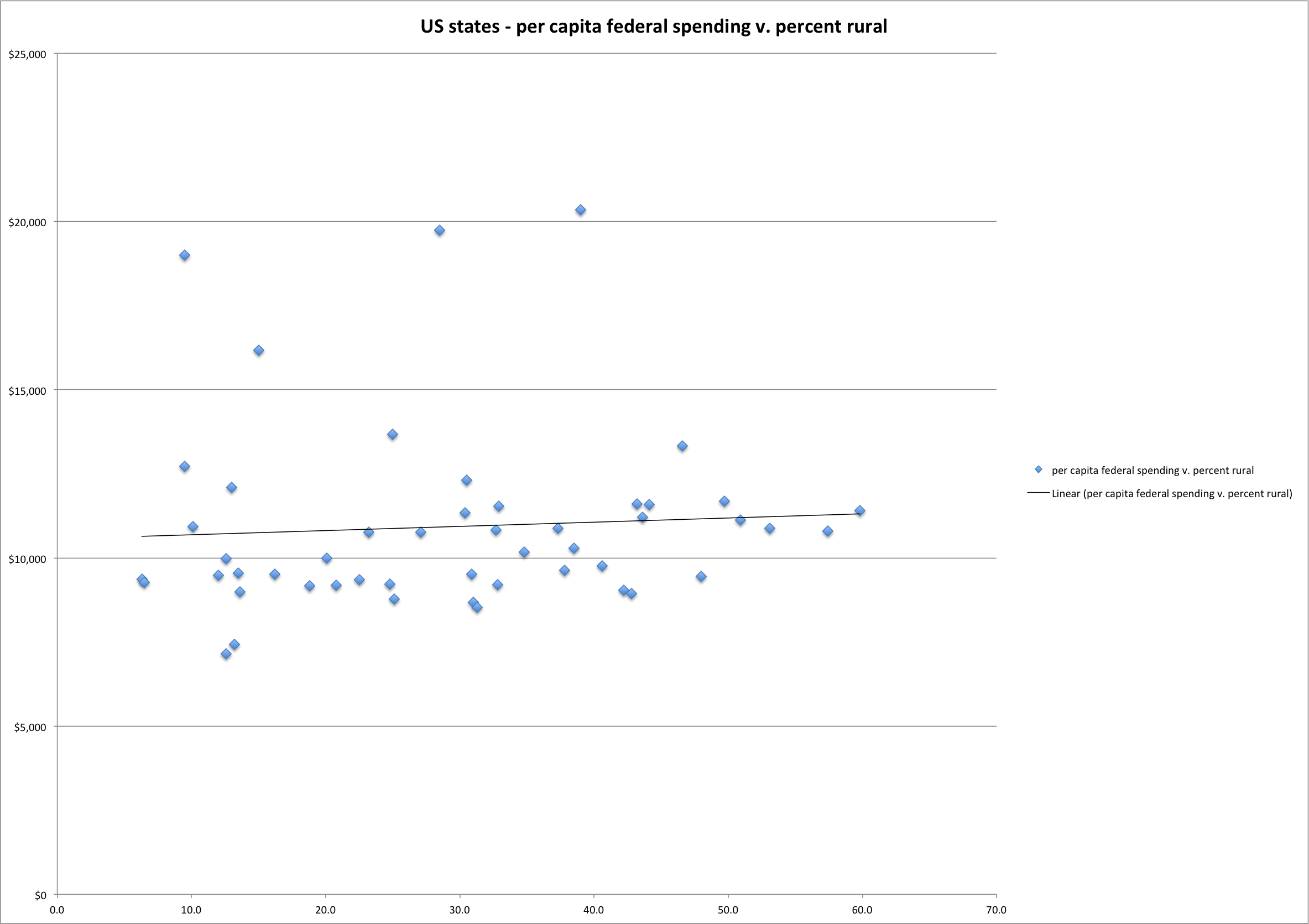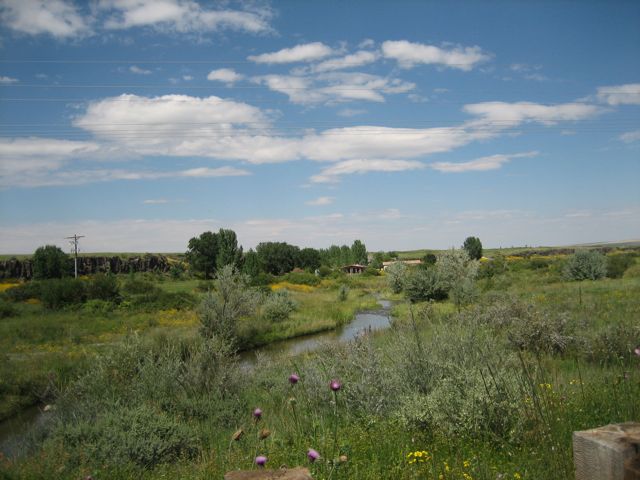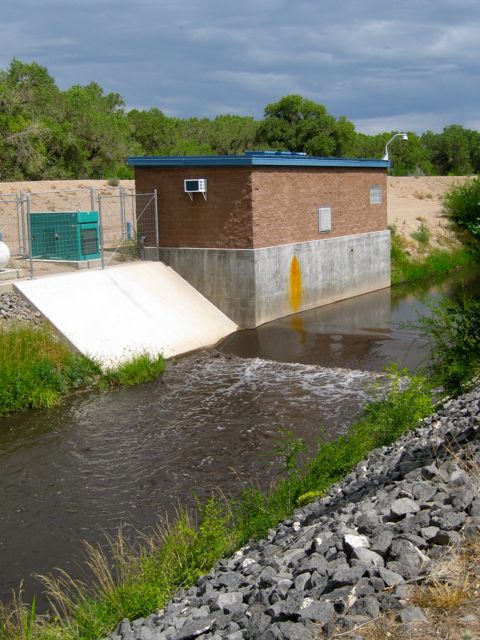Update: I was just waving my arms here, but a commenter who actually knows what s/he is talking about has stepped in with some valuable assistance. So skip my post below and just read this:
The data you’re looking for can be found here, at the county level: http://www.ers.usda.gov/briefing/ruraldevelopment/developments.htm
Like any data set, it’s open to interpretation. Overall, metro counties outperform nonmetro counties.
->You can break it down by region, to show that in the Northeast and South, urban areas outpace rural ones – while in the Midwest and the West, rural ones capture more federal dollars.
->You can try to differentiate transfers from procurement – that is, money the government redistributes from money the government spends to buy the things it needs. Defense dollars alone produce a $1k/capita rural/urban gap, because although many bases are rural, the real money goes to manufacturers, researchers, and health care. The same gap is visible using the more general ‘procurement’ category.
->But from where I sit, the most interesting difference is the three-part division between urbanized, less urban, and totally rural. Split things this way, and it’s a whole new ballgame. Counties that are genuinely rural – as opposed to, say, exurban – clearly outperform their urban and less urban counterparts. The same holds true for counties that are dependent on agriculture. And the two biggest single drivers are ‘grants’ and ‘direct payments other than for individuals.’ Rural counties aren’t capturing more dollars than urbanized counties just because their residents are older and poorer – those effects are actually fairly small (retirement/disability generates a $300 gap, and direct payments to individuals (EITC, UI) another $650). They’re capturing more dollars because they’re the beneficiaries of a variety of federal programs that target them for grants, bloc payments, and subsidies.
Really, this isn’t surprising. It’s also not seriously contested by economists. Rural areas enjoy outsize political clout, and they convert that into greater spending per capita. The gap would be even larger, but for the fact that these calculations include things the government buys, and most of those things are produced in urban areas.
Previously…
Warning: I’m operating totally outside my areas of journalistic expertise here, so this could be utter bullshit. More caveats to come. That said….
My friends at Stanford’s Rural West Inititative (disclosure – I’m sort of one of them) yesterday were linking off to a discussion of the potential effect of federal budget cuts on the rural United States. The Los Angeles Times kicked off the discussion with this:
The budget-cutting fervor in Washington is forcing lawmakers to reconsider not just the total amount they spend, but also where the dollars are going and why. The recipients with the most to lose are the ones in rural America, who are almost twice as reliant on federal largesse as city dwellers and suburbanites.
The folks at Daily Yonder clicked on the links in the Times piece and called the big urban paper out:
No matter how you look at it, rural “recipients” are not twice as reliant on transfer payments (medical benefits, Social Security, etc.). But, okay, rural residents are older and poorer, so they receive more of these transfer payments. Fine. This is a good point, even if the specifics are all messed up.
But then the Times conflates transfer payments with ALL federal spending. To tell you the truth, we can’t understand what the paper is saying. The paper says that “six of the 10 states where the federal government spent the most per capita are rural and people living on farms and in small towns collected 20% more on average in federal benefits than city dwellers.”
What the heck does that mean? What’s a “rural” state? (There are only five states in the country with a majority of residents living in rural counties after all.) Vermont is the most rural state in the country. Is Vermont on this list? We doubt it.
The Times original editorial is mostly about rural airport subsidies, which is one of those federal spending topics that leaves me feeling a bit like the drunk looking for his keys under the streetlight. By that I mean that it’s not very likely that we’ll find anything useful with regard to large scale systemic federal spending issues by studying the airport subsidy question. But hey, it’s all lit up over there, so why not give it a look?
The thing is, to first approximation, this analysis is not at all hard. And the result seems to be that the rural-not rural divide has only an itsy bitsy relationship to per capita federal spending in the states:
That’s total per capita spending by state (the y axis) vs. percent rural population, with a linear fit thrown in. The four graphically obvious outliers (per capital federal spending greater than $15k) are Maryland and Virginia (DC spillover), Alaska and Hawaii (big defense dollars per capita, I guess ’cause you can see Russia and China from there or something). It’s a bit crude (the per capita spending data is from 2009, the most recent percent rural data I could find was from the 2000 Census), but that ought to be enough of a back-of-the-envelope calculation to suggest that the rural-urban divide among states explains very little of the variance in per capita federal spending.
Sources:
- Consolidated Federal Funds Report (per capita spending, table 10)
- Statistical Abstract of the United States (table 29)
NB: For the newspaper, I spent a bunch of time last week looking at how the federal government spends money in New Mexico, so I think the underlying questions – who gets money now, and how that might change under the current “budget cutting” process. The (sub/ad req) column is here. But I’ve not really thought much in any rigorous way about the rural/urban federal spending divide, so this analysis may be totally pants.






